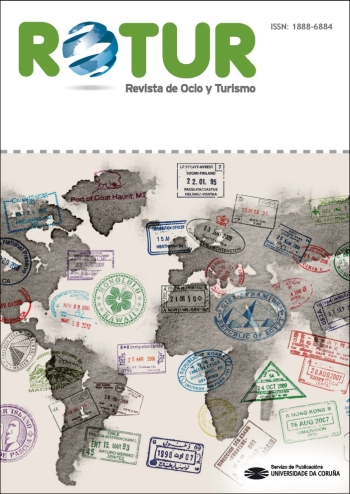Analysis of Social Media to support definition and evaluation of tourism public policy. The case of the Way of Saint James. The case of the Saint James Way
Main Article Content
Abstract
Sustainable public tourism policy management can benefit from learning about the perceptions of visitors and residents. While the views of the former can help to better satisfy their preferences, the latter can assist in identifying threats to the sustainability of tourism
activities, and satisfaction with how tourism is managed. Information shared on social media has proved a useful resource for the study of perceptions, but the approach needs to be adapted in order to deal with the specific features of tourism. The aim of this article is to
assess the use of social media in the design and assessment of public tourism policy from the perspective of sustainability and in relation to the specific case of the Way of St James. The artificial intelligence algorithms used show a clearly positive assessment of the tourist experience at present, and identify a set of possible measures to improve the sustainability of the underlying policies: 1) preserve and promote natural and cultural heritage; 2) facilitate integration of visitors with local communities, and 3) improve supply in sectors such as restaurants, logistics and safety. The results of the study have been shared through the the Social Data Lab repository at Harvard University Dataverse in order to facilitate the verification and reuse of the study data by the scientific community at large.
Keywords:
Downloads
Metrics
Article Details
References
Ali, Alisha e Frew, Andrew (2012). Information and Communication Technologies for Sustainable Tourism. Routledge. https://doi.org/10.4324/9780203072592
Ayeh, Julian K., Leung, Daniel, Au, Norman e Law, Rob (2012). Perceptions and Strategies of Hospitality and Tourism Practitioners on Social Media: An Exploratory Study. Em Matthias Fuchs, Francesco Ricci e Lorenzo Cantoni (eds.), Information and Communication Technologies in Tourism 2012 (pp. 1–12). Springer Vienna.
Birkland, Thomas A. (2015). An introduction to the policy process: Theories, concepts, and models of public policy making. Routledge.
Dye, Thomas (1992). Understanding Public Policy, 7th ed. Prentice Hall.
Easton, David (1965). A Framework for Political Analysis. Prentice-Hall.
Fernández Méndez, Diana, Fernández Fernández, Melchor e Riveiro García, Dolores (2019). “Impacto socioeconómico del Camino de Santiago a nivel local: la percepción de los residentes”. Documentos de Traballo. Análise Económica, 69, 1–39.
Gerston, Larry N. (2014). Public policy making: Process and principles. Routledge.
Gamallo, Pablo e García, Marcos (2017). LinguaKit: Uma ferramenta multilingue para a análise linguística e a extração de informação. Linguamática, 9(1), 19-28. https://doi.org/10.21814/lm.9.1.243
Torres Feijó, Elias J. (2020). Bem-estar comunitário e visitantes através do Caminho em Santiago. Grandes narrativas, ideias e práticas culturais na cidade. Andavira.
Flores-Ruiz, David, Elizondo-Salto, Adolfo, & de la O. Barroso-González, María (2021). Using Social Media in Tourist Sentiment Analysis: A Case Study of Andalusia during the Covid-19 Pandemic. Sustainability, 13, 3836.
Hall, Colin M., e Jenkins, John M. (1995). Tourism and Public Policy. Routledge.
Hennink, Monique e Kaiser, Bonnie N. (2019). Saturation in Qualitative Research. Em P. Atkinson, S. Delamont, A. Cernat, J.W. Sakshaug, e R.A. Williams (eds.), SAGE Research Methods Foundations. https://dx.doi.org/10.4135/9781526421036822322
Iriarte, Álvaro, Gamallo, Pablo e Simões, Alberto (2018). Estratégias Lexicométricas para Detetar Especificidades Textuais. Linguamática, 10, 19–26.
Iriarte, Álvaro e Sotelo, Susana (2022). Análise lexicométrica: Algumas técnicas aplicadas a entrevistas a visitantes de Santiago de Compostela. Em I. Caamaño, R. Samartim, & C. Lamela (eds.), Cidades, turismo e caminhos de Santiago / Ciudades, turismo y caminos de Santiago. Andavira.
McNamee, Paul (2005). Language Identification: A Solved Problem Suitable for Undergraduate Instruction. Journal of Computing Sciences in Colleges, 20(3), 94–101.
Medhat, Waala, Hassan, Ahmed, & Korashy, Hoda (2014). Sentiment analysis algorithms and applications: A survey. Ain Shams Engineering Journal, 5(4), 1093–1113. https://doi.org/10.1016/j.asej.2014.04.011
Mitjia T (2015). Evaluating language identification performance. Engineering. https://blog.twitter.com/engineering/en_us/a/2015/evaluating-language-identification-performance
Mittelstaedt, John D. e Mittelstaedt, Robert A. (2012). “Pilgrimage as Exchange: The Economy of Salvation and the Theory of Exchange”. 37th Macromarketing Conference, 373-376.
Munar, Ana María e Jacobsen, Jens Kr. Steen (2014). Motivations for sharing tourism experiences through social media. Tourism Management, 43, 46–54. https://doi.org/10.1016/j.tourman.2014.01.012
OCS (2009). Informe do perfil do peregrino. Informe anual 2009. Informe Observatorio do Camiño de Santiago.
OCS (2017). Estudio do impacto socio-económico do Camiño de Santiago. Informe técnico. Observatorio do Camiño de Santiago.
Pearce, Douglas G. (1992). Tourist Organisations. Longman Scientific and Technical.
Putra, Rino S., Nurcahyo, Rahmat e Gabriel, Djoko S. (2019). Tourists Perception in Bali Using Social Media and Online Media Sentiment Analysis. 2019 IEEE 6th International Conference on Engineering Technologies and Applied Sciences (ICETAS), 1–5. https://doi.org/10.1109/ICETAS48360.2019.9117317
Sanderson, Ian (2002). Evaluation, policy learning and evidence‐based policy making. Public administration, 80(1), 1-22.
Singh, Prabhsimran, Dwivedi, Yogesh K., Kahlon, Karanjeet S., Sawhney, Ravinder S., Alalwan, Ali A. e Rana, Nripendra P. (2020). Smart Monitoring and Controlling of Government Policies Using Social Media and Cloud Computing. Information Systems Frontiers, 22(2), 315–337. https://doi.org/10.1007/s10796-019-09916-y
Sotelo Docío, Susana e Benítez-Baleato, Jesus M. (2021). Replication Data for: Digital Tracks: Application of Artificial Intelligence Technologies for Automatic detection of Perceptions from Social Media. The case of the Saint James Way, with a focus on COVID-19 (V1 ed.). Harvard Dataverse. https://doi.org/10.7910/DVN/CUFZKT
Xiang, Zheng, Du, Qianzhou, Ma, Yufeng e Fan, Weiguo (2017). A comparative analysis of major online review platforms: Implications for social media analytics in hospitality and tourism. Tourism Management, 58, 51–65. https://doi.org/10.1016/j.tourman.2016.10.001
Xunta de Galicia (2020). Ocupación hoteleira no Camiño Francés. Informe técnico. Área de Estudos e Investigación, Turismo de Galicia. https://www.turismo.gal/aei/portal/index.php?idm=37
Zeng, Benxiang e Gerritsen, Rolf (2014). What do we know about social media in tourism? A review. Tourism Management Perspectives, 10, 27–36. https://doi.org/10.1016/j.tmp.2014.01.001
Zhang, Hailong, Gan, Wenyan e Jiang, Bo (2014). Machine Learning and Lexicon Based Methods for Sentiment Classification: A Survey. 2014 11th Web Information System and Application Conference, 262–265. https://doi.org/10.1109/WISA.2014.55
Zhang, Lei, Wang, Shuai e Liu, Bing (2018). Deep learning for sentiment analysis: A survey. WIREs Data Mining and Knowledge Discovery, 8(4), e1253. https://doi.org/10.1002/widm.1253







